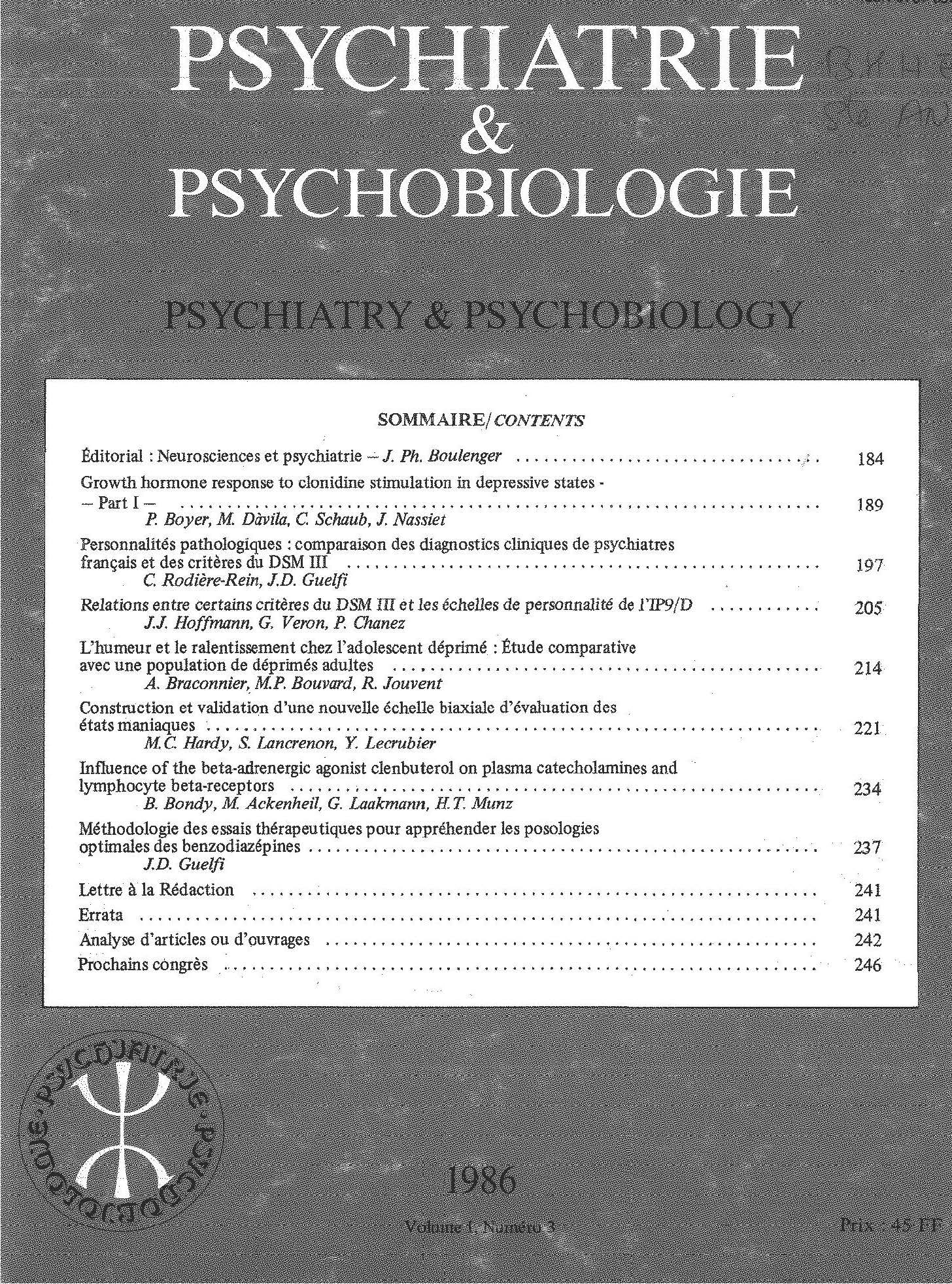No CrossRef data available.
Article contents
Récepteurs sérotoninergiques 5-HT1D et antidépresseurs
Published online by Cambridge University Press: 28 April 2020
Résumé
Divers sous-types de récepteurs sérotoninergiques de type 5-HT1 ont été mis en évidence. Ils correspondent aux soustypes 5-HT1A (marqué sélectivement par le 8-OH-DPAT), 5-HT1B marqué par le propranolol et certains bêta-antagonistes et présent seulement chez le rat et la souris, absent chez l’homme) et 5-HT1C (marqué par la mésulergine et présent en particulier dans les plexus choroïdes). Un sous-type supplémentaire 5-HT1 non A, non B, non C a été mis en évidence; il est caractérisé par un site de liaison insensible aux concentrations de ligands inhibant sélectivement les sous-types 5-HT1A, 5-HT1B et 5-HT1C, il correspond à un système de transduction adénylcyclasique (activation ou inhibition) et apparaît enfin jouer un rôle important dans la modulation présynaptique de la libération de neurotransmetteurs - non sérotoninergiques - en particulier l’acétylcholine. Ces caractéristiques ont été mises en évidence sur des préparations membranaires de cortex de mammifères par des essais in vitro de liaison de [3H]5-HT, de mesure d’activité adénylcyclasique sur les mêmes préparations et par mesure de libération évoquée de [3H] acétylcholine à partir de préparations synaptosomales de diverses régions cérébrales de rat et de cobaye. Une analyse par autoradiographie quantitative a été réalisée chez l’homme sur des coupes fines de cortex frontal prélevées post-mortem chez des individus normaux et des individus déprimés; les résultats obtenus suggèrent une légère augmentation des sites 5-HT1 non A, non b, non c chez les individus déprimés versus les cerveaux normaux. Les antidépresseurs à faibles concentrations (10 à 100 nM) sont capables d’interagir in vitro avec le fonctionnement de ce récepteur: au niveau du site de reconnaissance en altérant les caractéristiques de liaison de la [3H]5-HT, à celui du système de transduction adénylcyclasique en inhibant l’activation induite par la 5-HT et enfin au niveau de l’effet cellulaire sérotoninergique en réversant partiellement l’effet inhibiteur du trilîuorophénylméthylpipérazine (TFMPP), un agoniste sérotoninergique, sur la libération évoquée d’acétylcholine. Cet effet est observé avec des antidépresseurs inhibiteurs d’uptake de la 5-HT mais aussi avec des inhibiteurs d’uptake de la noradrénaline et non pas avec des benzodiazépines ou des neuroleptiques. Ces résultats suggèrent I’hypothèse selon laquelle le système sérotoninergique fonctionnant à l’aide des récepteurs 5-HT1 non A, non B, non c pourrait réguler la libération de divers autres neurotransmetteurs entraînant par là une régulation du nombre des récepteurs correspondants à ceux-ci. Les antidépresseurs pourraient interagir avec cet effet modulateur sérotoninergique vraisemblablement altéré au cours de pathologies dépressives ou accompagnant celle-ci.
Summary
Various subtypes of 5-hydroxytryptumine (5-HT) have been characterized through their recognition sites and their transduction system: 5-HT1A are labelled by 8-OH-DPAT, 5-HT1B by cyanopindolol and 5-HT1C by mesulergine. A 4th subtype has been observed recently 5-HT1 non A, non B, non C (5-HT1D for some authors) which is defined as being insensitive to concentrations of drugs selectively labelling 5-HT1A, 5-HT1B or 5-HT1C. This subtype is related to a stimulation or an inhibition of the activity of an adenylate cyclase. The function of this receptor corresponds to the presynaptic modulation of the release of other neurotransmitters (ie acetylcholine). Antidepressants, either inhibiting or non-inhibiting the uptake of 5-HT or that of noradrenalin, interacted with the binding of 5-HT on this receptor subtype, altered the adenylate cyclase function and partially reversed the effect of TFMPP (a 5-HT agonist) on the synaptosomal evoked release of [3H]ACh. The number of 5-HT1 non A, non B, non C subtypes might be slightly increased in frontal cerebral cortex of depressed versus normal one as determined by quantitative autoradiography in brain slices. These results suggest that the modulating effect of 5-HT on the function of other neurotransmitter systems might be involved in depression and that antidepressants might interact selectively with these receptors.
Keywords
- Type
- Article Original
- Information
- Copyright
- Copyright © European Psychiatric Association



Comments
No Comments have been published for this article.